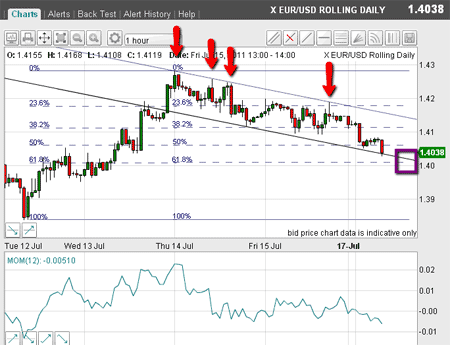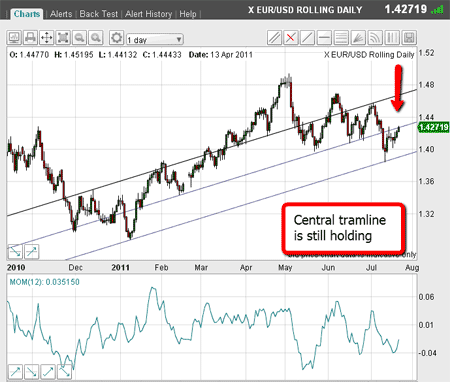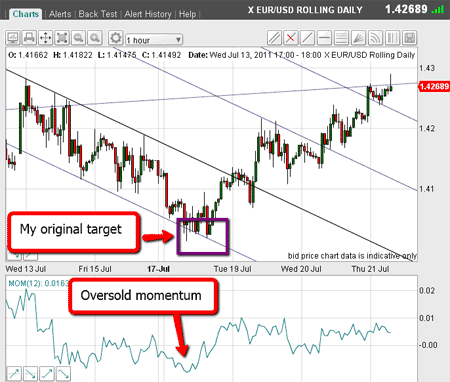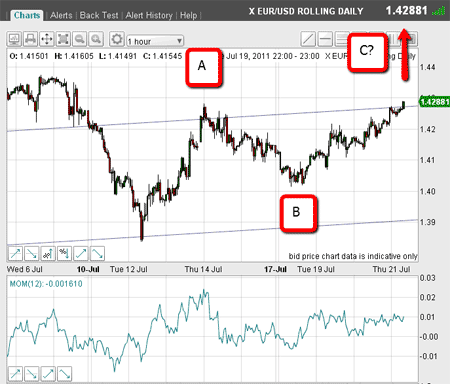Timing trades in a volatile market
The euro continues to swing wildly - despite its woes, it rallied this week. So how should traders play it? John C Burford explains how to time trades, and looks at where the wildly volatile euro market could turn next.
With the media this week whipping themselves into a frenzy over the prospects of a break-up of the eurozone caused by the seemingly imminent bond default by the peripheral eurozone members (PIIGS) they are being, once again, caught wrong-footed.
The euro has rallied this week! Aren't the markets perverse? They certainly seem to confuse the majority.
My aim is to help you develop a mindset where you get positioned ahead of the curve.
Subscribe to MoneyWeek
Subscribe to MoneyWeek today and get your first six magazine issues absolutely FREE

Sign up to Money Morning
Don't miss the latest investment and personal finances news, market analysis, plus money-saving tips with our free twice-daily newsletter
Don't miss the latest investment and personal finances news, market analysis, plus money-saving tips with our free twice-daily newsletter
Incidentally, the media cover completed market action and try to rationalise the moves. We can use this (in a contrarian way) to our benefit.
When I left it on Monday, the market was coming off last Thursday's high in a beautiful tramline fashion. This is the chart as of Monday:

(Click on the chart for a larger version)
On this chart, I pointed to a target marked by the purple box in the 1.4038 area.
Now, we cannot be too precise when setting our targets. There is natural noise' caused by short-term factors.
Setting 'time targets' for your trades
But within 20-30 pips, I was able to set that target band in price and time. The actual low was 1.4014.
This brings up an interesting point, which I haven't really focused on before time targets. But this is a very good time to bring it up, as it is entirely possible to set time targets for your trades.
When using my tramlines, we have natural boundaries for the price target. Prices will continue to be bound within the channel defined by the tramlines until they break out.
One other price target is provided by the Fibonacci 61.8% retracement level, as shown in the chart.
And where the two lines meet is roughly the point in price and time we can target. This is a very simple chart-based procedure.
OK, so where are we now, three days later? Here is this morning's chart:

(Click on the chart for a larger version)
On the daily chart, the market has rallied right back to my central tramline. I consider this a very strong support/resistance line.
One of the reasons for this is that when I drew my lowest tramline (which was drawn parallel), it passed right through the very significant lows in January and the 1.3850 low earlier in July.
So this central tramline will be very tough to break through. But it can happen.
Let's examine the picture if this scenario plays out. (As I write this morning, the market is being turned back at the 1.4280 level).
As we know, if we are in a euro bear market (which is proving very complex, to say the least!), all rallies should be variants of the basic A-B-C variety.
There should be three clear waves up before resuming the downtrend.
And here is the picture on the hourly chart:

(Click on the chart for a larger version)
My original target on Monday was the low (on oversold momentum) and the rally waves have trundled up, guided by my multiple tramlines to where we are now at the major central tramline.
This market is very volatile which way will it swing next?
This rally could well be a wave C of the relief recovery off the oversold 1.380 low. Here is the hourly chart:

(Click on the chart for a larger version)
Wave A is the rally to the 1.4290 high last week. Wave B is the dip, and we are currently in wave C.
A very common relationship between the waves is for the length (in price) of waves A and C to be equal.
That would put a target for the top of wave C at the 1.4450 level a full 70 pips above my central tramline and well into the channel above it.
But to get there, it must first overcome the huge resistance at the tramline. After all, it has held the line several times in recent trading.
Short-term traders will be shorting here and putting a close stop just above the tramline.
If stopped out, the odds would then swing to this latter scenario, where I will be looking to short again.
Because this market is exhibiting extreme volatility around the political developments, I will continue with it tomorrow.
As I said before, I continue to expect big moves in my markets and this summer will be anything but quiet.
Don't miss my next trading insight. To receive all my spread betting blog posts by email, as soon as I've written them, just sign up here .
Get the latest financial news, insights and expert analysis from our award-winning MoneyWeek team, to help you understand what really matters when it comes to your finances.
John is is a British-born lapsed PhD physicist, who previously worked for Nasa on the Mars exploration team. He is a former commodity trading advisor with the US Commodities Futures Trading Commission, and worked in a boutique futures house in California in the 1980s.
He was a partner in one of the first futures newsletter advisory services, based in Washington DC, specialising in pork bellies and currencies. John is primarily a chart-reading trader, having cut his trading teeth in the days before PCs.
As well as his work in the financial world, he has launched, run and sold several 'real' businesses producing 'real' products.
-
 ‘Inheritance tax insurance’ enquiries are soaring – but is it worth it?
‘Inheritance tax insurance’ enquiries are soaring – but is it worth it?Premiums for whole of life insurance can run to £5,000 a month to cover a £300,000 inheritance tax bill, with policies costing more the older you take them out.
-
 MPs warn over Lifetime ISAs which could leave savers out of pocket
MPs warn over Lifetime ISAs which could leave savers out of pocketThe Treasury Committee has highlighted confusion around the Lifetime ISA withdrawal charge, which risks consumers losing “a significant part of their savings”